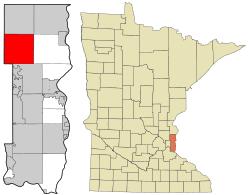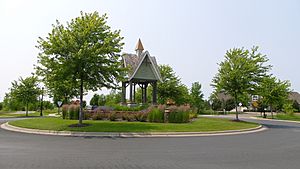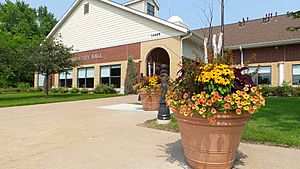Hugo, Minnesota facts for kids
Quick facts for kids
Hugo
|
|
|---|---|

Location of the city of Hugo
within Washington County, Minnesota |
|
| Country | United States |
| State | Minnesota |
| County | Washington |
| Area | |
| • Total | 36.03 sq mi (93.33 km2) |
| • Land | 33.46 sq mi (86.66 km2) |
| • Water | 2.57 sq mi (6.67 km2) |
| Elevation | 929 ft (283 m) |
| Population
(2020)
|
|
| • Total | 15,766 |
| • Density | 471.18/sq mi (181.92/km2) |
| Time zone | UTC-6 (Central (CST)) |
| • Summer (DST) | UTC-5 (CDT) |
| ZIP code |
55038
|
| Area code(s) | 651 |
| FIPS code | 27-30392 |
| GNIS feature ID | 2394440 |
| Website | City of Hugo |
Hugo (pronounced HEW-goh) is a city located about 18 miles (29 km) north of downtown Saint Paul. It is in Washington County, which is part of the U.S. state of Minnesota. In 2020, the city had a population of 15,766 people.
Hugo is situated north of White Bear Lake. It is on the edge of the larger Minneapolis-St. Paul metropolitan area. This big urban area is the sixteenth largest in the United States.
Oneka Lake, the city's largest lake, has a special name. It comes from the Dakota word "onakan." This word means "to strike or knock off" wild rice into a canoe. Just south of Oneka Lake is Rice Lake. Here, the Mdewakanton Dakota people from Mendota used to gather wild rice.
Contents
Exploring Hugo's Past: A Brief History
Hugo was first settled by French Canadians. It became an important stop for the Lake Superior and Mississippi Railroad. This railroad later became known as the Northern Pacific Railway. Trains would stop here to get more fuel.
The community was originally part of Oneka Township. It was first called Centerville Station before being named Hugo. How Hugo got its name is still a bit of a mystery. Some local stories say it was named after the famous French writer, Victor Hugo. This makes sense because many French-Canadian settlers lived in the area.
Another idea is that it was named after Trevanion William Hugo, a mayor of Duluth. However, the name "Hugo" was already in use by the village post office before he moved from Canada. The Oneka Township itself was also named by French-Canadians. They used the Dakota word "onakan," which means to gather wild rice.
The village of Hugo officially became a village in 1906. It then became a city in 1972. After the year 2000, Hugo grew a lot. Many new homes and businesses were built, making it the busy city it is today.
Understanding Hugo's Location: Geography
According to the United States Census Bureau, the city of Hugo covers a total area of about 36.02 square miles (93.3 square kilometers). Most of this area, about 33.45 square miles (86.6 square kilometers), is land. The remaining 2.57 square miles (6.7 square kilometers) is water.
The city has clear boundaries. Elmcrest Avenue North is on its west side. Keystone Avenue North is on its east side. 180th Street North marks its northern edge, and 120th Street North is its southern border.
A main road that runs through Hugo is U.S. Highway 61. This highway goes from north to south. While Interstate 35E is not directly in Hugo, many residents use it. It is located just west of the city. Washington County Road 8 (also Anoka County Road 14) connects U.S. 61 to Interstate 35E.
Who Lives in Hugo? Demographics
| Historical population | |||
|---|---|---|---|
| Census | Pop. | %± | |
| 1910 | 204 | — | |
| 1920 | 246 | 20.6% | |
| 1930 | 303 | 23.2% | |
| 1940 | 348 | 14.9% | |
| 1950 | 440 | 26.4% | |
| 1960 | 538 | 22.3% | |
| 1970 | 751 | 39.6% | |
| 1980 | 3,771 | 402.1% | |
| 1990 | 4,417 | 17.1% | |
| 2000 | 6,363 | 44.1% | |
| 2010 | 13,332 | 109.5% | |
| 2020 | 15,766 | 18.3% | |
| U.S. Decennial Census | |||
Hugo's Population in 2020
The 2020 census showed that 15,766 people lived in Hugo. These people lived in 5,512 different homes.
Most of the people in Hugo, about 94.7%, were White. About 1.0% were African American, and 2.4% were Asian. About 1.8% of the population identified as being from two or more races. People of Hispanic or Latino background made up 2.9% of the population.
In terms of households, 40.4% had children under 18 living there. Most homes, 60.8%, were married couples. About 9.2% of homes had a female head of household without a husband. And 4.2% had a male head of household without a wife.
The average number of people in a household was 2.67. For families, the average size was 3.09 people.
Looking at age groups, 25.9% of Hugo's population was under 18 years old. About 7.3% were under 5 years old. And 11.6% were 65 years old or older. The population of Hugo is also slightly more female, with 51% being female.
Hugo's Population in 2010
The 2010 census counted 13,332 people living in Hugo. There were 4,990 households, and 3,704 of these were families. The city had about 398.6 people per square mile (153.9 people per square kilometer).
The racial makeup of the city in 2010 was similar to 2020. About 94.2% were White. 0.7% were African American, and 3.1% were Asian. People of Hispanic or Latino background made up 2.2% of the population.
In 2010, 27.9% of residents were under 18 years old. About 33.9% were between 25 and 44 years old. The median age in Hugo was 33.7 years. The population was almost evenly split between genders, with 49.2% male and 50.8% female.
See also
 In Spanish: Hugo (Minnesota) para niños
In Spanish: Hugo (Minnesota) para niños




